Jifeng Dai
GenExam: A Multidisciplinary Text-to-Image Exam
Sep 17, 2025



Abstract:Exams are a fundamental test of expert-level intelligence and require integrated understanding, reasoning, and generation. Existing exam-style benchmarks mainly focus on understanding and reasoning tasks, and current generation benchmarks emphasize the illustration of world knowledge and visual concepts, neglecting the evaluation of rigorous drawing exams. We introduce GenExam, the first benchmark for multidisciplinary text-to-image exams, featuring 1,000 samples across 10 subjects with exam-style prompts organized under a four-level taxonomy. Each problem is equipped with ground-truth images and fine-grained scoring points to enable a precise evaluation of semantic correctness and visual plausibility. Experiments show that even state-of-the-art models such as GPT-Image-1 and Gemini-2.5-Flash-Image achieve less than 15% strict scores, and most models yield almost 0%, suggesting the great challenge of our benchmark. By framing image generation as an exam, GenExam offers a rigorous assessment of models' ability to integrate knowledge, reasoning, and generation, providing insights on the path to general AGI.
InternVL3.5: Advancing Open-Source Multimodal Models in Versatility, Reasoning, and Efficiency
Aug 25, 2025Abstract:We introduce InternVL 3.5, a new family of open-source multimodal models that significantly advances versatility, reasoning capability, and inference efficiency along the InternVL series. A key innovation is the Cascade Reinforcement Learning (Cascade RL) framework, which enhances reasoning through a two-stage process: offline RL for stable convergence and online RL for refined alignment. This coarse-to-fine training strategy leads to substantial improvements on downstream reasoning tasks, e.g., MMMU and MathVista. To optimize efficiency, we propose a Visual Resolution Router (ViR) that dynamically adjusts the resolution of visual tokens without compromising performance. Coupled with ViR, our Decoupled Vision-Language Deployment (DvD) strategy separates the vision encoder and language model across different GPUs, effectively balancing computational load. These contributions collectively enable InternVL3.5 to achieve up to a +16.0\% gain in overall reasoning performance and a 4.05$\times$ inference speedup compared to its predecessor, i.e., InternVL3. In addition, InternVL3.5 supports novel capabilities such as GUI interaction and embodied agency. Notably, our largest model, i.e., InternVL3.5-241B-A28B, attains state-of-the-art results among open-source MLLMs across general multimodal, reasoning, text, and agentic tasks -- narrowing the performance gap with leading commercial models like GPT-5. All models and code are publicly released.
Spatial Frequency Modulation for Semantic Segmentation
Jul 16, 2025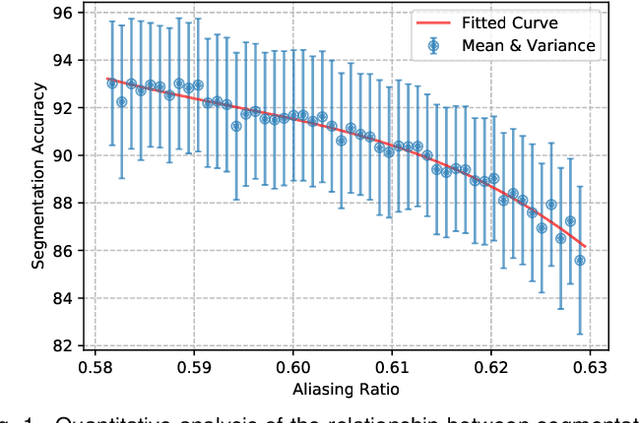
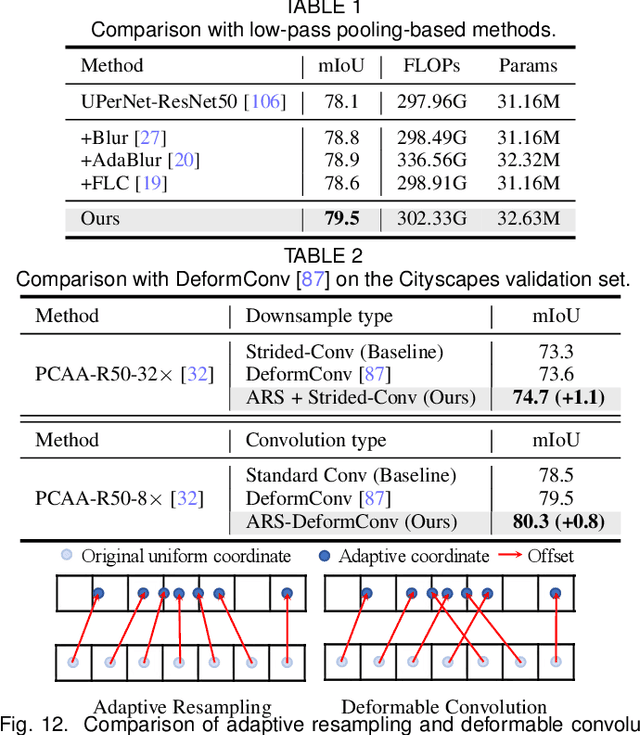
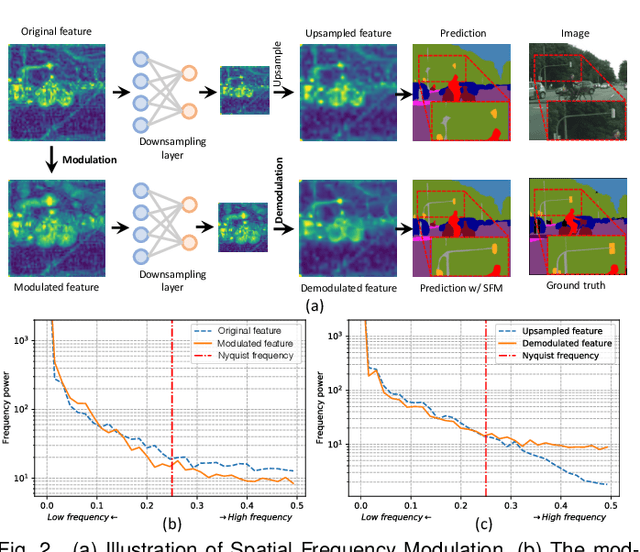
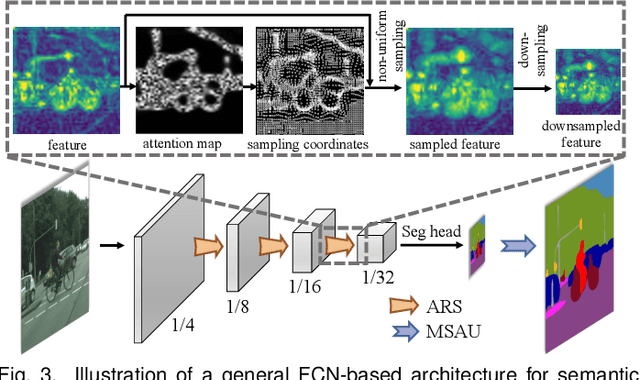
Abstract:High spatial frequency information, including fine details like textures, significantly contributes to the accuracy of semantic segmentation. However, according to the Nyquist-Shannon Sampling Theorem, high-frequency components are vulnerable to aliasing or distortion when propagating through downsampling layers such as strided-convolution. Here, we propose a novel Spatial Frequency Modulation (SFM) that modulates high-frequency features to a lower frequency before downsampling and then demodulates them back during upsampling. Specifically, we implement modulation through adaptive resampling (ARS) and design a lightweight add-on that can densely sample the high-frequency areas to scale up the signal, thereby lowering its frequency in accordance with the Frequency Scaling Property. We also propose Multi-Scale Adaptive Upsampling (MSAU) to demodulate the modulated feature and recover high-frequency information through non-uniform upsampling This module further improves segmentation by explicitly exploiting information interaction between densely and sparsely resampled areas at multiple scales. Both modules can seamlessly integrate with various architectures, extending from convolutional neural networks to transformers. Feature visualization and analysis confirm that our method effectively alleviates aliasing while successfully retaining details after demodulation. Finally, we validate the broad applicability and effectiveness of SFM by extending it to image classification, adversarial robustness, instance segmentation, and panoptic segmentation tasks. The code is available at \href{https://github.com/Linwei-Chen/SFM}{https://github.com/Linwei-Chen/SFM}.
CoMemo: LVLMs Need Image Context with Image Memory
Jun 06, 2025


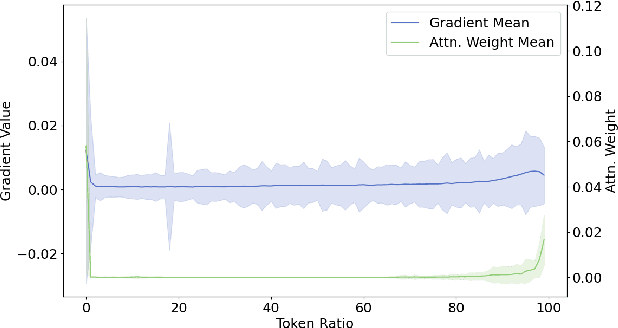
Abstract:Recent advancements in Large Vision-Language Models built upon Large Language Models have established aligning visual features with LLM representations as the dominant paradigm. However, inherited LLM architectural designs introduce suboptimal characteristics for multimodal processing. First, LVLMs exhibit a bimodal distribution in attention allocation, leading to the progressive neglect of middle visual content as context expands. Second, conventional positional encoding schemes fail to preserve vital 2D structural relationships when processing dynamic high-resolution images. To address these limitations, we propose CoMemo - a dual-path architecture that combines a Context image path with an image Memory path for visual processing, effectively alleviating visual information neglect. Additionally, we introduce RoPE-DHR, a novel positional encoding mechanism that employs thumbnail-based positional aggregation to maintain 2D spatial awareness while mitigating remote decay in extended sequences. Evaluations across seven benchmarks,including long-context comprehension, multi-image reasoning, and visual question answering, demonstrate CoMemo's superior performance compared to conventional LVLM architectures. Project page is available at https://lalbj.github.io/projects/CoMemo/.
OWMM-Agent: Open World Mobile Manipulation With Multi-modal Agentic Data Synthesis
Jun 04, 2025Abstract:The rapid progress of navigation, manipulation, and vision models has made mobile manipulators capable in many specialized tasks. However, the open-world mobile manipulation (OWMM) task remains a challenge due to the need for generalization to open-ended instructions and environments, as well as the systematic complexity to integrate high-level decision making with low-level robot control based on both global scene understanding and current agent state. To address this complexity, we propose a novel multi-modal agent architecture that maintains multi-view scene frames and agent states for decision-making and controls the robot by function calling. A second challenge is the hallucination from domain shift. To enhance the agent performance, we further introduce an agentic data synthesis pipeline for the OWMM task to adapt the VLM model to our task domain with instruction fine-tuning. We highlight our fine-tuned OWMM-VLM as the first dedicated foundation model for mobile manipulators with global scene understanding, robot state tracking, and multi-modal action generation in a unified model. Through experiments, we demonstrate that our model achieves SOTA performance compared to other foundation models including GPT-4o and strong zero-shot generalization in real world. The project page is at https://github.com/HHYHRHY/OWMM-Agent
Point or Line? Using Line-based Representation for Panoptic Symbol Spotting in CAD Drawings
May 29, 2025Abstract:We study the task of panoptic symbol spotting, which involves identifying both individual instances of countable things and the semantic regions of uncountable stuff in computer-aided design (CAD) drawings composed of vector graphical primitives. Existing methods typically rely on image rasterization, graph construction, or point-based representation, but these approaches often suffer from high computational costs, limited generality, and loss of geometric structural information. In this paper, we propose VecFormer, a novel method that addresses these challenges through line-based representation of primitives. This design preserves the geometric continuity of the original primitive, enabling more accurate shape representation while maintaining a computation-friendly structure, making it well-suited for vector graphic understanding tasks. To further enhance prediction reliability, we introduce a Branch Fusion Refinement module that effectively integrates instance and semantic predictions, resolving their inconsistencies for more coherent panoptic outputs. Extensive experiments demonstrate that our method establishes a new state-of-the-art, achieving 91.1 PQ, with Stuff-PQ improved by 9.6 and 21.2 points over the second-best results under settings with and without prior information, respectively, highlighting the strong potential of line-based representation as a foundation for vector graphic understanding.
ZeroGUI: Automating Online GUI Learning at Zero Human Cost
May 29, 2025Abstract:The rapid advancement of large Vision-Language Models (VLMs) has propelled the development of pure-vision-based GUI Agents, capable of perceiving and operating Graphical User Interfaces (GUI) to autonomously fulfill user instructions. However, existing approaches usually adopt an offline learning framework, which faces two core limitations: (1) heavy reliance on high-quality manual annotations for element grounding and action supervision, and (2) limited adaptability to dynamic and interactive environments. To address these limitations, we propose ZeroGUI, a scalable, online learning framework for automating GUI Agent training at Zero human cost. Specifically, ZeroGUI integrates (i) VLM-based automatic task generation to produce diverse training goals from the current environment state, (ii) VLM-based automatic reward estimation to assess task success without hand-crafted evaluation functions, and (iii) two-stage online reinforcement learning to continuously interact with and learn from GUI environments. Experiments on two advanced GUI Agents (UI-TARS and Aguvis) demonstrate that ZeroGUI significantly boosts performance across OSWorld and AndroidLab environments. The code is available at https://github.com/OpenGVLab/ZeroGUI.
Learning Adaptive and Temporally Causal Video Tokenization in a 1D Latent Space
May 22, 2025Abstract:We propose AdapTok, an adaptive temporal causal video tokenizer that can flexibly allocate tokens for different frames based on video content. AdapTok is equipped with a block-wise masking strategy that randomly drops tail tokens of each block during training, and a block causal scorer to predict the reconstruction quality of video frames using different numbers of tokens. During inference, an adaptive token allocation strategy based on integer linear programming is further proposed to adjust token usage given predicted scores. Such design allows for sample-wise, content-aware, and temporally dynamic token allocation under a controllable overall budget. Extensive experiments for video reconstruction and generation on UCF-101 and Kinetics-600 demonstrate the effectiveness of our approach. Without additional image data, AdapTok consistently improves reconstruction quality and generation performance under different token budgets, allowing for more scalable and token-efficient generative video modeling.
EchoInk-R1: Exploring Audio-Visual Reasoning in Multimodal LLMs via Reinforcement Learning
May 07, 2025Abstract:Multimodal large language models (MLLMs) have advanced perception across text, vision, and audio, yet they often struggle with structured cross-modal reasoning, particularly when integrating audio and visual signals. We introduce EchoInk-R1, a reinforcement learning framework that enhances such reasoning in MLLMs. Built upon the Qwen2.5-Omni-7B foundation and optimized with Group Relative Policy Optimization (GRPO), EchoInk-R1 tackles multiple-choice question answering over synchronized audio-image pairs. To enable this, we curate AVQA-R1-6K, a dataset pairing such audio-image inputs with multiple-choice questions derived from OmniInstruct-v1. EchoInk-R1-7B achieves 85.77% accuracy on the validation set, outperforming the base model, which scores 80.53%, using only 562 reinforcement learning steps. Beyond accuracy, EchoInk-R1 demonstrates reflective reasoning by revisiting initial interpretations and refining responses when facing ambiguous multimodal inputs. These results suggest that lightweight reinforcement learning fine-tuning enhances cross-modal reasoning in MLLMs. EchoInk-R1 is the first framework to unify audio, visual, and textual modalities for general open-world reasoning via reinforcement learning. Code and data are publicly released to facilitate further research.
VisuLogic: A Benchmark for Evaluating Visual Reasoning in Multi-modal Large Language Models
Apr 21, 2025



Abstract:Visual reasoning is a core component of human intelligence and a critical capability for advanced multimodal models. Yet current reasoning evaluations of multimodal large language models (MLLMs) often rely on text descriptions and allow language-based reasoning shortcuts, failing to measure genuine vision-centric reasoning. To address this, we introduce VisuLogic: a benchmark of 1,000 human-verified problems across six categories (e.g., quantitative shifts, spatial relations, attribute comparisons). These various types of questions can be evaluated to assess the visual reasoning capabilities of MLLMs from multiple perspectives. We evaluate leading MLLMs on this benchmark and analyze their results to identify common failure modes. Most models score below 30% accuracy-only slightly above the 25% random baseline and far below the 51.4% achieved by humans-revealing significant gaps in visual reasoning. Furthermore, we provide a supplementary training dataset and a reinforcement-learning baseline to support further progress.
 Add to Chrome
Add to Chrome Add to Firefox
Add to Firefox Add to Edge
Add to Edge